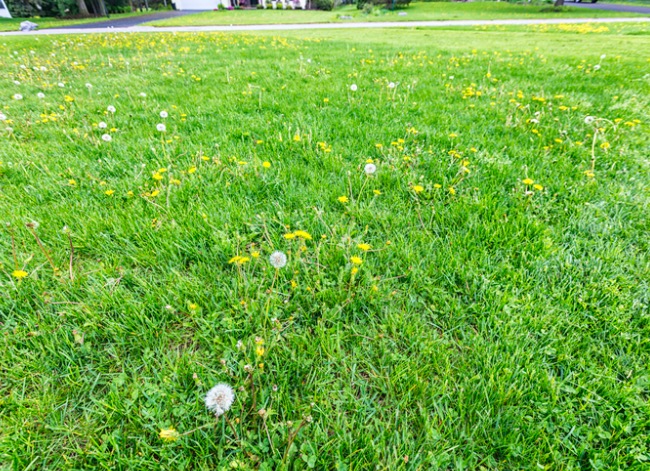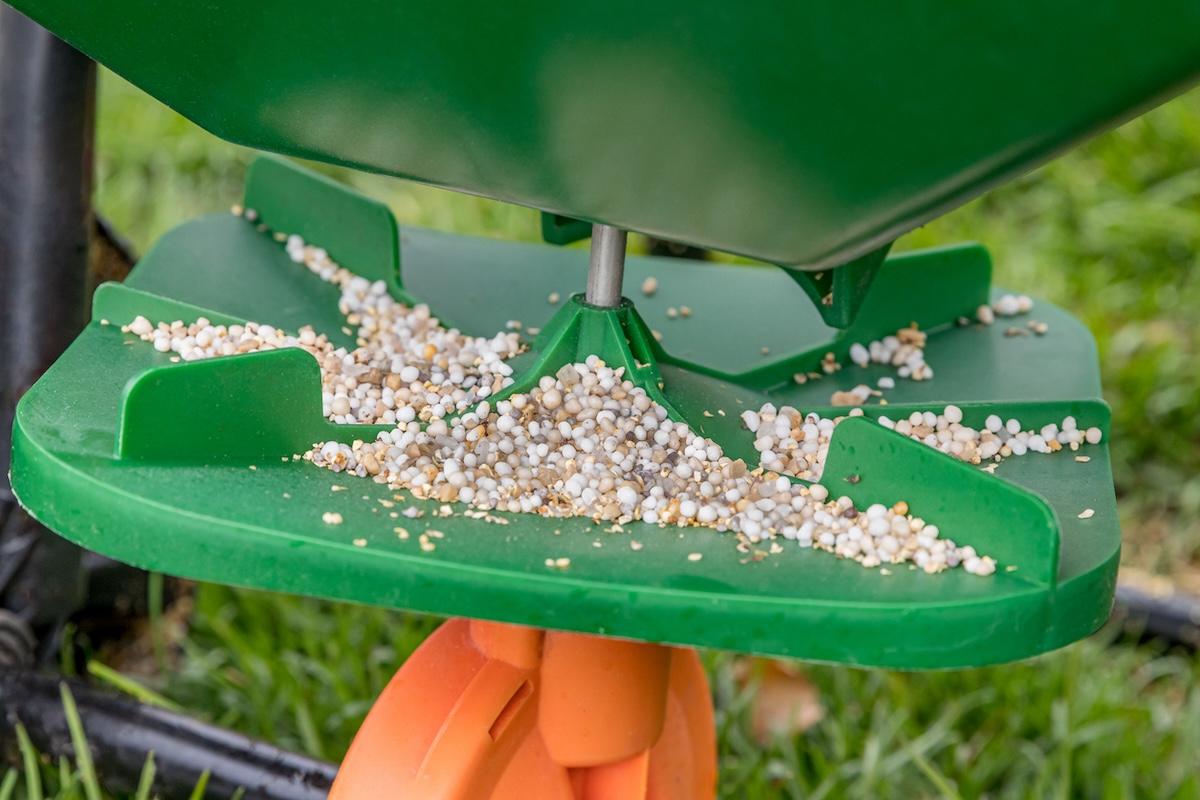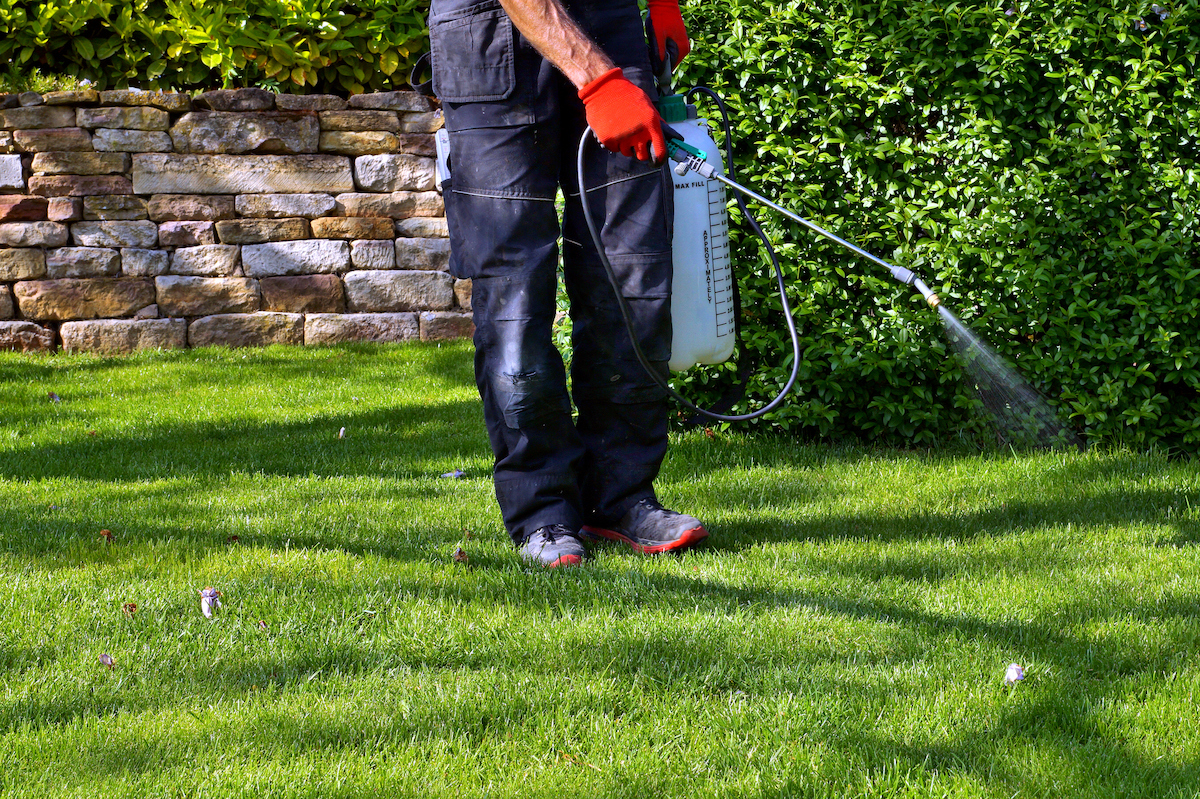We may earn revenue from the products available on this page and participate in affiliate programs. Learn More ›
Pre-emergent weed killers belong to a group of herbicides that don’t kill unwanted plants. Instead, they stop seeds from sprouting in the first place. Various pre-emergent products are available for lawns, vegetable gardens, and flower beds. Knowing when to apply pre-emergent herbicide can mean the difference between having a lush, weed-free lawn, a yard riddled with dandelions and other unwanted plants, or no lawn or flowers at all.
Applying pre-emergent weed killers too soon can keep beneficial seeds from sprouting, and applying them too late won’t do any good. “The most effective pre-emergence herbicides are nonselective,” says Alec Kowalewski, Ph.D., associate professor and turfgrass specialist at Oregon State University. “They will prevent the germination of any plant establishing from seed,” he says. Ahead, learn when to use pre-emergent herbicides—and when to wait.
Early spring is typically the most effective time to apply pre-emergent herbicides.
Applying a pre-emergent herbicide will prevent seeds from sprouting, and since most weeds (like crabgrass, foxtail, and sandbur) germinate in late spring and emerge in summer, spring is usually the best time to act. Kowalewski suggests using the herbicides in spring if there were heavy weed populations on the property the previous summer. Just be sure not to combine seeding of any desired grass or plant with the application of pre-emergents. It is best to avoid their use altogether during the first year following seeding or sodding of a lawn.
BobVila.com and our parent company, Recurrent Ventures, put conservation and sustainability at the forefront of much of what we do. Though the solutions offered in this content are all effective, not all of them are organic or sustainable. The staff of BobVila.com encourages readers to make informed choices about maintaining their home and property. We recommend starting with the least extreme solution, escalating only if necessary, and prioritizing solutions that will not have detrimental effects on the health and longevity of this planet and its inhabitants.
Apply pre-emergents in fall to stop winter weeds.
A lawn might appear virtually weed-free going into fall, but then weeds suddenly appear. By this time, the pre-emergent applied in spring is no longer protecting the yard or beds, and a few invasive weed seed varieties, such as annual bluegrass, henbit, and chickweed, are lying in wait for cooler temps before sprouting.
A bonus fall application can also help control the next year’s summer weeds. After sprouting, hardy weeds will remain small, perhaps even unnoticeable, throughout the winter. But they’ll revive in early spring and grow with a vengeance. By then, it’s too late to use a pre-emergent—a post-emergent herbicide is necessary at that point. Break this cycle by controlling weeds before they have a chance to sprout.

Apply pre-emergents when the temperature is right.
For spring application, “Some classic indicators for pre-emergence timing include atmospheric temperature that reaches 60 degrees Fahrenheit,” Kowalewski says. This will vary by region. For example, in southern USDA growing zones, such as Louisiana, appropriate temperatures typically hit around the first of March, while in North Dakota the temps will be more conducive to applying a pre-emergent in June.
One telltale sign for when to apply pre-emergent herbicides is the blooming of forsythia shrubs, which Kowalewski says is “a classic indicator that temperatures are getting close to summer annual germination.”
In the fall, apply pre-emergent herbicides when daytime temperatures drop to about 70 degrees, since many winter/early spring weeds begin to germinate at temps below that.
There are two types of pre-emergent herbicides, liquid and granular. Both work to keep weed seeds from sprouting, but one works a little better and more quickly.
Formulation slightly affects timing for pre-emergent herbicides.
- Liquid: Liquid herbicides, including pre-emergents, “are better than granular applications,” says Kowalewski. Think of them “as a blanket applied to the surface of the soil,” he says. Liquid herbicides can cover a wider surface area overall than granules can. Because they are in liquid form, they also act faster, whereas granules must first break down and bond with particles in the soil. Liquid products are easy to apply with a pump sprayer and come in either full strength or as concentrates that require diluting with water before use.
- Granular: Resembling tiny grains, granular pre-emergent products are applied using a drop spreader or a broadcast spreader, or even by shaking the granules onto the soil with a cup. Using a spreader works best for even coverage on large areas, such as lawns. Still, gardeners might prefer sprinkling the granules around established plants in a vegetable or flower garden using a cup, and then working the granules into the soil’s surface. “If granular applications are used, be sure to water these into the soil to improve activity,” says Kowalewski. It also helps to time application so that the granules are down before rainfall is expected.

Some active ingredients work better on summer weeds or winter weeds.
The active ingredients in specific pre-emergent weed killers can vary. Identifying the unwanted plants in your hard can help you choose the best pre-emergent and determine the best time to apply, whether for summer or winter annual weeds. Examples of active ingredients are:
- Pendimethalin, the active ingredient in Scotts Halts Crabgrass and Grassy Weed Preventer, can stop crabgrass, plus several other weeds like purslane and henbit. It is safe for use on crops. It might not be as effective for fall application.
- Prodiamine is used often for turfgrass but is not safe for edible plants or crops. It is mildly toxic to earthworms and comes in liquid and granular options.
- Trifluralin, the active ingredient in Preen, is nonselective; it will stop a variety of unwanted weed and grass seeds but is more likely to also affect seeds of desired plants. It is not safe for pets, lawns, or edibles.
- Corn gluten meal is an organic approach to pre-emergent control. The natural method doesn’t work as well as chemicals, but it is better for the soil and environment.
Clemson University Extension posts a helpful list of the best active ingredients to tackle summer weeds and grasses. Herbicide products help consumers by listing the types of weeds they should kill on the packaging, in addition to the herbicide’s active ingredients and warnings.
Reseeding a lawn too soon after applying a pre-emergent herbicide may prevent the grass seeds from sprouting.
Kowalewski cautions that spring is not a good time to use pre-emergent herbicides if you want to sow grass seed in the spring. “I would suggest [grass] seed or pre-emergence herbicides in the spring, not both,” says Kowalewski. He suggests that homeowners overseed (or interseed) and fertilize in those springs that follow low-weed summers. Keeping turf coverage full and healthy can help prevent weeds from finding a home.
Likewise, spring is not the time to treat the soil in a garden or annual flower bed where beneficial seeds, such as flowers, corn, cucumbers, or squash, will be sown, since pre-emergence products can affect their germination. But for lawns and perennial flower beds, treatment with pre-emergent herbicides in early spring can drastically reduce the number of annual summer weeds.
Sowing any seed while a pre-emergent herbicide is still effective will prevent the wanted seeds from sprouting. Check package directions, but generally wait a minimum of 8 to 9 weeks after applying a pre-emergent to overseed or sow annuals. With winter grass species like fescue, which need cool temps to sprout, avoid fall application of pre-emergents. Instead, overseed the lawn at that time, or alternate seeding and use of pre-emergents.
Always follow directions on herbicide packaging.
“Pre-emergent herbicides are generally safe on existing plants,” says Kowalewski. But they can prevent desired annual flowers or vegetables sown by seed from coming up, so timing is critical. “Be sure not to combine seeding with pre-emergence herbicides,” Kowalewski says. Check package labels to ensure that a particular formula is meant for the type of weeds you want to stop; knowing the desired targets will help determine the best time for application.
Likewise, consult the product’s label for specific safety requirements when applying pre-emergent herbicides. When you’re applying any pesticide, Kowalewski says it is best to wear “long pants, a long-sleeved shirt, shoes and socks, gloves, and protective glasses.” He also cautions to always shower after application, and to wash the clothes worn during application separately to reduce exposure. The effects of the ingredients vary among products, so be sure to read and follow all cautions regarding eye exposure, skin exposure, and possible toxicity to pets or children.
Final Thoughts
Avoid the need for pre-emergents or their repeated use by keeping lawns healthy and full, and by adding a 2- to 3-inch layer of mulch to beds in the spring to prevent weed seed growth. Plan timing of pre-emergents based on the type of weed, when it typically appears, and weather (both temperature and expected rainfall). For the best coverage, apply pre-emergents throughout a lawn or bed, not just where you have seen the weed grow. Using liquid formulas and watering after applying any pre-emergent herbicide will help spread the product’s coverage.


